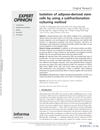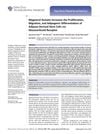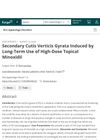Search
forResearch
5 / 1000+ resultsresearch In the Absence of Streptomycin, Minoxidil Potentiates the Mitogenic Effects of Fetal Calf Serum, Insulin-Like Growth Factor 1, and Platelet-Derived Growth Factor on NIH 3T3 Fibroblasts in a K+ Channel-Dependent Fashion
research Role of Platelet Rich Plasma in Treatment of Androgenetic Alopecia: Review Article
PRP therapy is a promising and effective treatment for hair loss with minimal side effects.

research Isolation of Adipose-Derived Stem Cells Using a Subfractionation Culturing Method
The new method for isolating stem cells from fat is simple and effective, producing cells that grow faster and are better for hair regeneration.

research Megestrol Acetate Increases the Proliferation, Migration, and Adipogenic Differentiation of Adipose-Derived Stem Cells via Glucocorticoid Receptor
Megestrol acetate helps fat-derived stem cells grow, move, and turn into fat cells through a specific receptor.

research Secondary Cutis Verticis Gyrata Induced by Long-Term Use of High-Dose Topical Minoxidil
Long-term use of high-dose topical minoxidil can cause thickened, ridged scalp.
Community Join
5 / 7 resultscommunity The Real Cause Of Androgenetic Alopecia
Androgenetic alopecia is caused by DHT affecting hair growth. Finasteride and minoxidil are used to manage hair loss by blocking DHT and promoting hair growth.
community New Treatments, and a Huge Group Buy with Lots of Research
A user is organizing a group buy for various compounds aimed at reversing hair loss and gray hair, and improving brain health and fat loss. The user has developed a treatment plan based on extensive research and is inviting others to participate, with the option to choose only the compounds they need.

community Compressed part of research of theory of androgenic/anabolitic balance. AGA h-responders analytic. Theory of physio-metabolitic method of anti AGA treatment
The treatment for androgenetic alopecia involves using finasteride and minoxidil with intense exercise and cold exposure to boost metabolism and reduce androgenic effects, potentially leading to hair regrowth. This approach may activate biological pathways for improved hair and overall health.
community Does RU58841 potentially cause cancer?
RU58841 may pose cancer risks due to its antiandrogen properties and lack of long-term safety data. Using it is considered a high-risk experiment with unknown potential for harm.
community New Study: PP405, developed by Pelage Pharmaceuticals, can reactivate dormant hair follicle stem cells and stimulate natural hair growth by 20%
PP405, developed by Pelage Pharmaceuticals, can reactivate dormant hair follicle stem cells and increase hair growth by 20% in eight weeks, unlike minoxidil or finasteride. However, skepticism remains about its effectiveness and availability, with concerns about funding and the timeline for broader access.